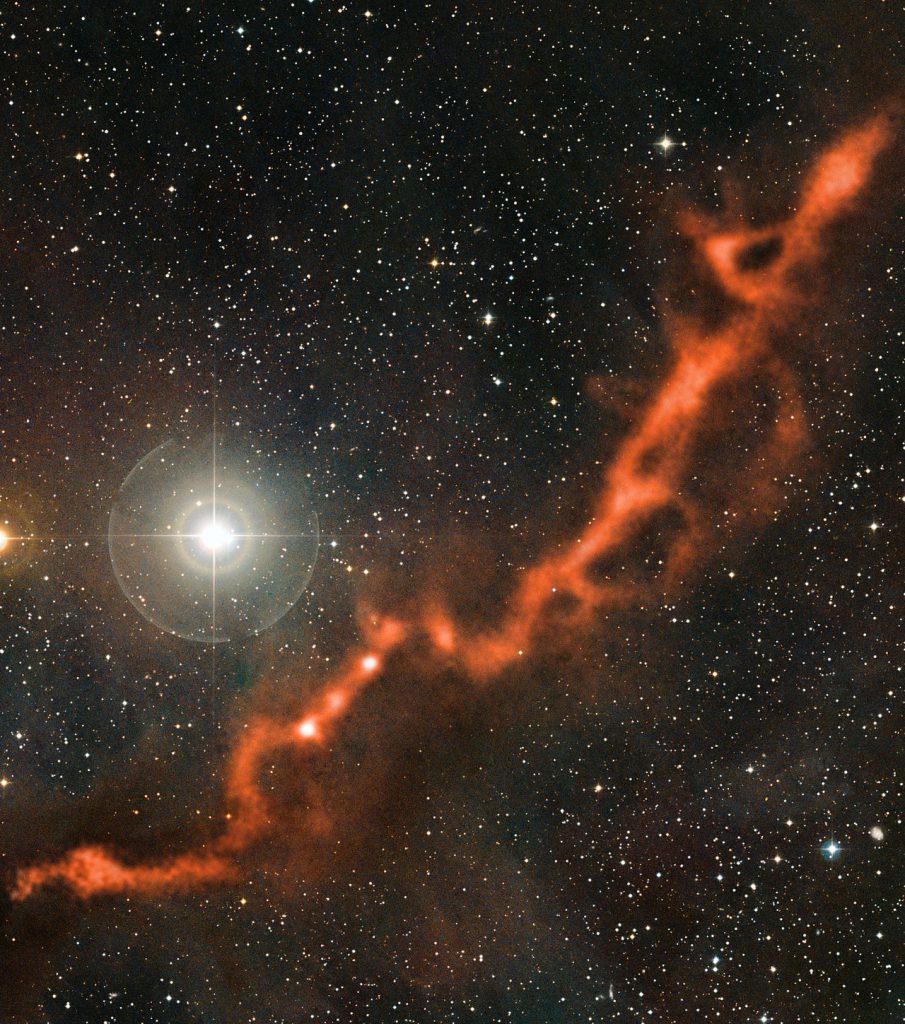Benzonitrile – A Most Exciting Discovery in the World of Astrochemistry
by Shagun Kothari

Scientists in the early 20th century were rather dubious about the idea that molecules existed within the vacuum of space, free from being bound to stars or planets. This could be ascribed to the fact that they were able to rationalize how any molecules in space would be destroyed but not necessarily how they were formed.
However, with advancements in astronomical facilities and laboratory spectroscopy, simple molecular species, carbon chains, complex organic molecules (COMs), fullerenes, and polycyclic aromatic hydrocarbons (PAHs) have been found to be omnipresent in the space environment. Molecules have been detected at every stage of stellar evolution and in regions and situations that might seem inhospitable to the formation and survival of chemical bonds.
Amongst these discoveries, the most exciting one might be the detection of benzonitrile, an intriguing organic molecule that helps to chemically link simple carbon-based molecules and truly massive ones like the PAHs.
Benzonitrile was spotted in an interstellar dust cloud 430 light-years away, known as the Taurus molecular cloud (TMC-1), using a radio telescope. It is the first time a specific aromatic molecule has been detected using radio spectroscopy.

Astrochemists have suspected that PAHs were widespread throughout the universe and were estimated to make up about 10% of all interstellar carbon. Despite their expected ubiquity, astronomical identification of specific aromatic molecules has been proven elusive until now. For instance, bond stretching motions in their infrared spectra are too similar to parse, and many PAHs lack strong polarity. This latter point makes signatures in their rotational spectra—typically collected with radio telescopes—difficult to detect. This has created a huge impediment in distinguishing one PAH from another.
For these reasons, in order to understand the chemistry of PAHs in interstellar medium, much effort has been centered on modeling the formation of readily detectable small five- and six-membered aromatic rings and their subsequent reactions with smaller hydrocarbons and nitrogen species to produce PAHs. Benzonitrile’s lopsided chemical arrangement allowed the chemists to identify nine distinct spikes in the radio spectrum that correspond to the molecule. They also could observe the additional effects of nitrogen nuclei on the radio signature.
Although, benzonitrile isn’t strictly a PAH because of the nitrogen it contains as well as the lack of multiple cycles, this molecule is the center of the attention currently because of its strong dipole moment and also because it forms from a reaction between benzene and cyanide, which may be able to help us estimate how much benzene, an aromatic compound, exists in space, as well as other molecules, if we are able to measure benzonitrile.
It is an exciting new discovery not only because it is a precursor to more complex PAHs and the fact that it sheds light on the composition of aromatic material within the interstellar medium — the material that will eventually be incorporated into new stars and planets. The detection of benzonitrile in space is also exciting also because it provides a chemical link to the carriers (PAHs) of the unidentified infrared bands. The intrinsic infrared emission from PAHs have been deduced as the likely culprit for as-yet unidentified infrared bands – emissions generated by numerous cosmic (galactic and extragalactic sources) sources. Hence, this discovery is a vital clue in a 30-year-old mystery: identifying the source of a faint infrared glow that permeates the Milky Way and other galaxies.
References:
- Ilsa R. Cooke et al 2020 ApJL 891 L41
- Jose J, Zamir A, Stein T. Molecular dynamics reveals formation path of benzonitrile and other molecules in conditions relevant to the interstellar medium. Proc Natl Acad Sci U S A. 2021;118(19):e2101371118. doi:10.1073/pnas.2101371118
- McGuire, B. A., Loomis, R. A., Burkhardt, A. M., Lee, K. L. K., Shingledecker, C. N., Charnley, S. B., … McCarthy, M. C. (2021). Detection of two interstellar polycyclic aromatic hydrocarbons via spectral matched filtering. Science, 371(6535), 1265–1269. doi:10.1126/science.abb7535
- McGuire BA, Burkhardt AM, Kalenskii S, Shingledecker CN, Remijan AJ, Herbst E, McCarthy MC. Detection of the aromatic molecule benzonitrile (c-C6H5CN) in the interstellar medium. Science. 2018 Jan 12;359(6372):202-205. doi: 10.1126/science.aao4890. PMID: 29326270.
- National Academies of Sciences, Engineering, and Medicine; Division on Earth and Life Studies; Chemical Sciences Roundtable; Mantus E, editor. Astrochemistry: Discoveries to Inform the Chemical Sciences and Engineering Communities: Proceedings of a Workshop—in Brief. Washington (DC): National Academies Press (US); 2019 Sep 12. Available from: https://www.ncbi.nlm.nih.gov/books/NBK546750/ doi: 10.17226/25541
Shagun Kothari is a third-year chemistry (honours) undergraduate at the University of Delhi and a research fellow at the Indian Academy of Sciences. She is a research associate for the BMSIS YSP and is working with Dr. Jim Cleaves on “Abiological degradation of biological organic materials using chemical reaction networks”.
